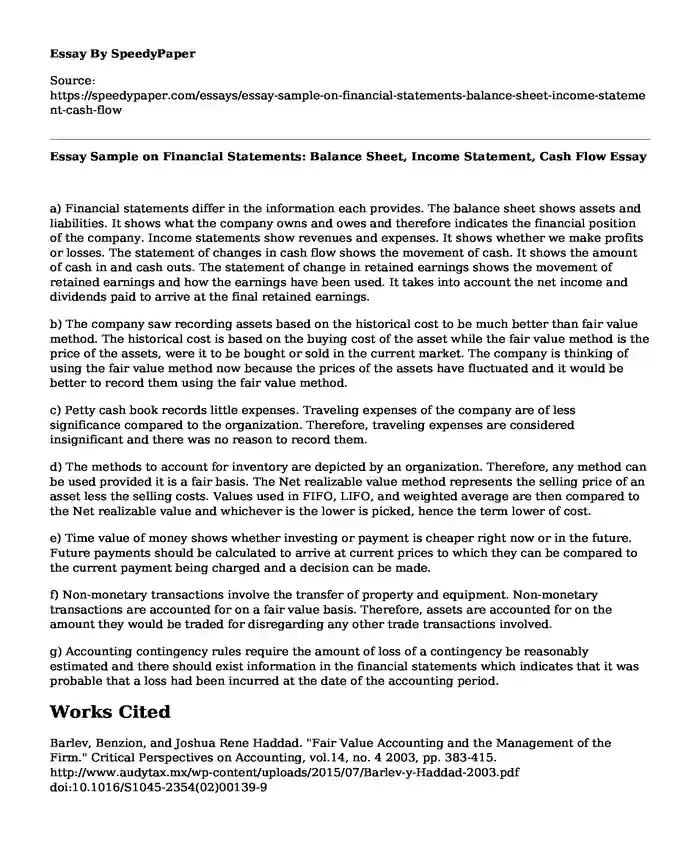
| Type of paper: | Essay |
| Categories: | Finance Business Accounting |
| Pages: | 2 |
| Wordcount: | 508 words |
a) Financial statements differ in the information each provides. The balance sheet shows assets and liabilities. It shows what the company owns and owes and therefore indicates the financial position of the company. Income statements show revenues and expenses. It shows whether we make profits or losses. The statement of changes in cash flow shows the movement of cash. It shows the amount of cash in and cash outs. The statement of change in retained earnings shows the movement of retained earnings and how the earnings have been used. It takes into account the net income and dividends paid to arrive at the final retained earnings.
b) The company saw recording assets based on the historical cost to be much better than fair value method. The historical cost is based on the buying cost of the asset while the fair value method is the price of the assets, were it to be bought or sold in the current market. The company is thinking of using the fair value method now because the prices of the assets have fluctuated and it would be better to record them using the fair value method.
c) Petty cash book records little expenses. Traveling expenses of the company are of less significance compared to the organization. Therefore, traveling expenses are considered insignificant and there was no reason to record them.
d) The methods to account for inventory are depicted by an organization. Therefore, any method can be used provided it is a fair basis. The Net realizable value method represents the selling price of an asset less the selling costs. Values used in FIFO, LIFO, and weighted average are then compared to the Net realizable value and whichever is the lower is picked, hence the term lower of cost.
e) Time value of money shows whether investing or payment is cheaper right now or in the future. Future payments should be calculated to arrive at current prices to which they can be compared to the current payment being charged and a decision can be made.
f) Non-monetary transactions involve the transfer of property and equipment. Non-monetary transactions are accounted for on a fair value basis. Therefore, assets are accounted for on the amount they would be traded for disregarding any other trade transactions involved.
g) Accounting contingency rules require the amount of loss of a contingency be reasonably estimated and there should exist information in the financial statements which indicates that it was probable that a loss had been incurred at the date of the accounting period.
Works Cited
Barlev, Benzion, and Joshua Rene Haddad. "Fair Value Accounting and the Management of the Firm." Critical Perspectives on Accounting, vol.14, no. 4 2003, pp. 383-415. http://www.audytax.mx/wp-content/uploads/2015/07/Barlev-y-Haddad-2003.pdf doi:10.1016/S1045-2354(02)00139-9
Frishkoff, Paul. "An Empirical Investigation of the Concept of Materiality in Accounting." Journal of Accounting Research (1970): 116-129. doi: 10.2307/2674697
Jonathan Schiff, Allen Schiff, and Hannah Rozen. "Accounting For Contingencies: Disclosure of Future Business Risks." Management Accounting Quarterly 13.3 (2012): 1. https://www.imanet.org/-/media/8654f03aa1034508ad919cb0c56f4871.ashx
Cite this page
Essay Sample on Financial Statements: Balance Sheet, Income Statement, Cash Flow. (2022, Dec 26). Retrieved from https://speedypaper.net/essays/essay-sample-on-financial-statements-balance-sheet-income-statement-cash-flow
Request Removal
If you are the original author of this essay and no longer wish to have it published on the SpeedyPaper website, please click below to request its removal:
- Free Essay about the Effects of Childhood Obesity in America
- Franklin D Roosevelt Domestic Policy in Our Free Essay Example
- Financial Audit Essay Example
- Law Essay Sample on Mistakes, Fraud, and Voluntary Consent
- Free Essay - Interview on Child Development
- Date Trump Immigration Ban
- Essay Sample on Impact of Marx's Ideological Extremism on the Relationship Between Nations
Popular categories




